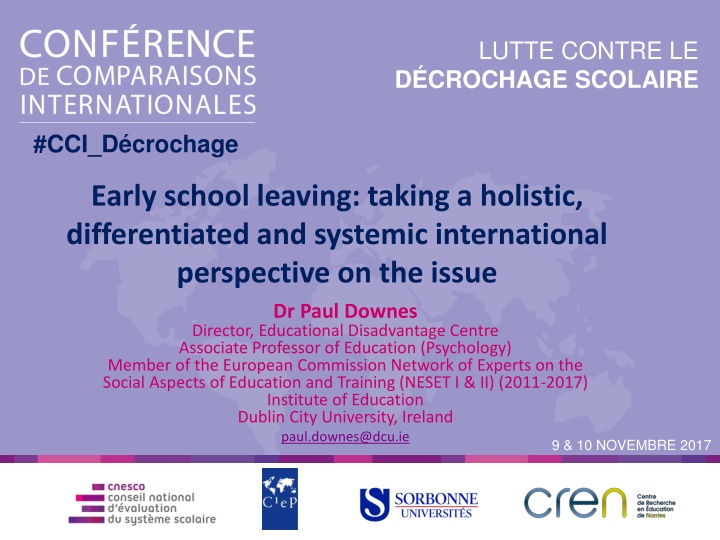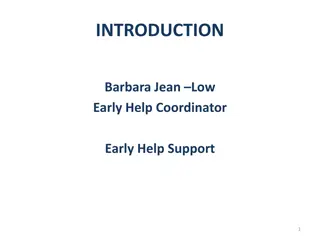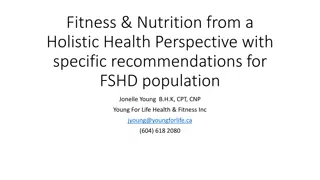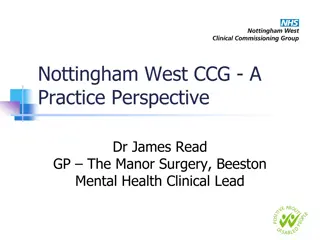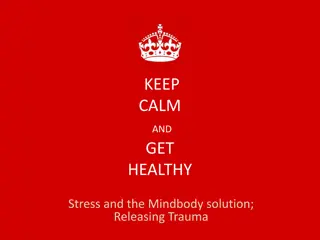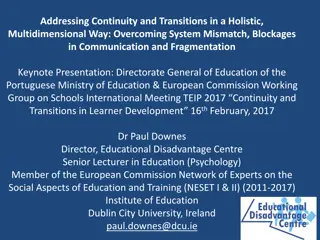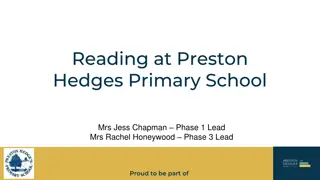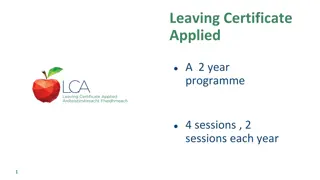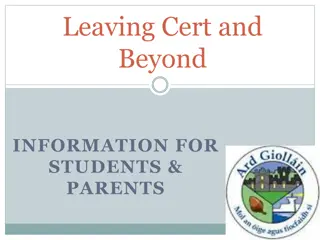International Perspective on Early School Leaving: A Holistic Approach
Taking a holistic, differentiated, and systemic view of early school leaving, Dr. Paul Downes offers an insightful perspective on educational disadvantage. As an Associate Professor of Education and member of the European Commission Network of Experts, he brings a wealth of knowledge to this crucial issue.
Download Presentation

Please find below an Image/Link to download the presentation.
The content on the website is provided AS IS for your information and personal use only. It may not be sold, licensed, or shared on other websites without obtaining consent from the author.If you encounter any issues during the download, it is possible that the publisher has removed the file from their server.
You are allowed to download the files provided on this website for personal or commercial use, subject to the condition that they are used lawfully. All files are the property of their respective owners.
The content on the website is provided AS IS for your information and personal use only. It may not be sold, licensed, or shared on other websites without obtaining consent from the author.
E N D
Presentation Transcript
LUTTE CONTRE LE D CROCHAGE SCOLAIRE #CCI_D crochage Early school leaving: taking a holistic, differentiated and systemic international perspective on the issue Dr Paul Downes Director, Educational Disadvantage Centre Associate Professor of Education (Psychology) Member of the European Commission Network of Experts on the Social Aspects of Education and Training (NESET I & II) (2011-2017) Institute of Education Dublin City University, Ireland paul.downes@dcu.ie 9 & 10 NOVEMBRE 2017
Downes, P., Nairz-Wirth, E., Rusinaite, V. (2017). Structural Indicators for Inclusive Systems in and around Schools. Luxembourg: Publications Office of the European Union. Cefai,C., Curricular Reform in Social and Emotional Education across the EU. A review of the international evidence. Luxembourg: Publications Office of the European Union. Bartolo, C., Cavioni, P & Downes, P. ( 2017, forthcoming) Downes, P. & Cefai, C. (2016) How to tackle bullying and prevent school violence in Europe: Evidence and practices for strategies for inclusive and safe schools. Luxembourg: Publications Office of the European Union. Edwards, A. & Downes, P. (2013) Alliances for Inclusion: Developing Cross- sector Synergies and Inter-Professional Collaboration in and around Education. Brussels: European Education and Culture. Commission, Directorate General, Cedefop 2017 Early Leaving from VET Selfreflection Tool.
Sartre Bad faith is to pretend something is necessary which is in fact voluntary . France: Early School Leaving France Foreign- born Native- born 2013 2016 9.7 % 8.8 % 16.3 % 8.2 %
Key Guiding Principles (Downes Nairz-Wirth & Rusinaite 2017): Holistic - Recognises the social, emotional and physical needs, and not simply the academic and cognitive ones, of both children/young people and their parents; Systemic - Beyond individual resilience to inclusive systems; Differentiated not one size fits all. Inclusive systems - Beyond Rutter s (1987) resilience in adversity (poverty, early school leaving, bullying, trauma) as superman or wonderwoman ! (Downes 2017).
I feel like I belong at school, % Agree (S.E.) I feel like an outsider (or left out of things at school), % Disagree (S.E.) 89.9 (1.1) 88.4 (1.0) 80.5 (1.6) Countries Holistic Systemic Issues: Percentage of Socioeconomically Disadvantaged Students who Agree/Disagree with the Following Statements: School Belonging and Feeling Like an Outsider (PISA 2012, OECD 2012). Austria Belgium Czech Republic Denmark Estonia Finland France Germany Greece Hungary Ireland Italy United Kingdom OECD Average 82 (1.6) 63.5 (1.6) 73.6 (1.9) 69.3 (1.6) 78.2 (1.8) 80.5 (1.1) 38 (1.7) 83.8 (1.6) 87.8 (1.2) 83.5 (1.1) 76.7 (1.5) 75 (0.9) 74.9 (1.5) 90.3 (1.0) 90.0 (1.3) 89.2 (1.0) 73.2 (1.8) 89.7 (1.4) 83.9 (1.4) 85.6 (1.6) 91.6 (1.0) 89.3 (0.6) 86.9 (1.1) 78.1 (0.3) 86.2 (0.2)
Differentiated Strategies in Place - for Meeting Individual Needs at Different Levels of Need/Risk for Transition: Universal (All); Selected (Some, Groups, Moderate Risk). Indicated Individual, Intensive, Chronic Need
Universal Strategies Preventing Grade Retention and Postponing Tracking (OECD 2007, 2010). Preventing Child Poverty and its Impact on Mental Health (Kessler 2009, Annie E. Casey Foundation 2009, WHO 2003). Social and Emotional Education (children, teachers).
A Holistic Curricular Focus on Social and Emotional Education A study of more than 213 programs found that if a school implements a quality SEL curriculum, they can expect better student behaviour and an 11 point increase in test scores (Durlak et al., 2011). Durlak et al. (2011) highlight a range of SEL benefits indirectly related to bullying and school violence, for outcomes on SEE skills, Attitudes, Positive Social Behaviour, Conduct Problems, Emotional Distress and Academic Performance. Sklad et al. s (2012) meta-analysis promote development rather than prevent specific problems such as bullying. SEE programs showed statistically significant effects on social skills, antisocial behaviour, substance abuse, positive self- image, academic achievement and prosocial behaviour. SEE - Not the same as civic or religious education !
UNIVERSAL AND SELECTED Initial Teacher Education Conflict Resolution Skills Bullying: Discriminatory Bullying. Classroom Climate and Elam s (2013) 10 country European study regarding the fundamental importance of teacher influence on discriminatory bullying: Those immigrant and Roma students who think the teacher exhibits similar behaviour towards native and immigrant and Roma children in the class are those bullied least in the last 3 months. In contrast, those who declare that their teacher favours native children over immigrant/Roma students are more vulnerable to suffer some form of bullying [across the 10 countries] (Elam , 2013).
Authoritarian teaching (Downes & Maunsell 2007, Pyh lt et al. 2010, Cefai & Cooper 2010, Downes 2013). WHO (2012) Modifications that appear to have merit include: establishing a caring atmosphere autonomy; providing positive feedback; not publicly humiliating students who perform poorly; identifying and promoting young people s special interests and skills to acknowledge that schools value the diversity they bring. that promotes Paul Ricoeur (1978) Distanciation between subject and object.
Commission Staff Working Document (2011) Frequency of measures against Early School Leaving mentioned in National Reports across Europe Early childhood education and care 30 Targeted individual support Prolongation of compulsory education Anti-segregation measures and support for disadvantaged schools Recognition and validation of prior learning 25 Support for children with different mother tongue 20 Reintegration into mainstream education 15 2nd chance education Involvement of parents 10 5 Financial support for pupils Flexibility and permeability of pathways 0 Guidance and counselling Improving VET Individualised learning approaches Link education and business Mentoring, tutoring, individual educational support School development Extra-curricular activities Early warning systems Teacher education Networking with parents and local community
Parental Involvement (Downes, 2014a): Availability of School Site After School Hours for Lifelong Learning Classes for Parents Country On a scale of 1-3 where 3 means at least 80% of schools in your municipality open their doors after school hours for lifelong learning classes and 2 means at least 30% of schools do so and 1 means less than 30% of schools do so which number best describes the situation in your municipality? 3 3 2 2 1 1 1 1 1 The Hague Gijon Tallinn Stockholm Antwerp Usti Munich Nantes Sofia
Sleep aspects linked to academic achievement, mental health Taras & Potts-Datema (2005) note that most children need at least 9 hours of restful sleep each night and conclude that: The preponderance of literature that recognises the detrimental effects of sleep disorders is astounding and perhaps not fully appreciated among many primary care providers, school health professionals and educators . Attention, reasoning and memory, moreover during prolonged periods of sleep restriction, the negative effects accumulate (de Bruin et al., 2016). Other international studies have shown a relationship between insufficient sleep and lowered academic performance (Blunden et al., 2001; Boschloo et al., 2011; Kronholm, 2015 ).
Selected and Indicated Prevention Even apart from poverty related depression, emotional distress contributes to early school leaving: LONELINESS: Frostad et al. 2015 intention to drop out. Quiroga et al. (2013): 493 high-risk French-speaking adolescents living in Montreal. Depression symptoms at the beginning of secondary school are related to higher dropout mainly by being associated with pessimistic views about the likelihood to reach desired school outcomes; student negative self-beliefs are in turn related to lower self-reported academic performance and predict a higher risk of dropping out. Quiroga et al. (2013) interventions that target student mental health and negative self-perceptions are likely to improve dropout prevention .
The downward spiral of mental disorders and educational attainment: a systematic review on early school leaving (Pascale EschEmail author, Val ry Bocquet, Charles Pull, Sophie Couffignal, Torsten Lehnert, Marc Graas, Laurence Fond-Harmant and Marc Ansseau. BMC Psychiatry 2014 14:237). When adjusted for socio-demographic factors, mood disorders (e.g. depression) were significantly related to school dropout. Among anxiety disorders, after controlling for potentially confounding factors, social phobia was a strong predictor of poor educational outcomes . as indicated by early school leavers themselves, were feeling too nervous in class and being anxious to speak in public, both representing symptoms of social phobia .
School Climate, Teasing, Bullying Cornell et al. (2013) a climate of teasing and bullying in the school also deserves consideration. Notably, the increased dropout count that was associated with Prevalence of Teasing and Bullying was quite similar to the increases that were associated with FRPM [i.e., poverty] and academic failure . Cornell et al. (2013) note that dropout programs often focus too narrowly on changes in individual students, without considering broader peer and school influences. Supports could intervene at an early stage to prevent the escalation of experiential processes, such as selfdoubting and double victimising, described in a Swedish context (Thornberg et al., 2013), hopelessness in a US context (Radliff et al. 2015).
Inclusive Systems Approach (Downes & Cefai 2016): There is a striking commonality of interests with regard to strategic approaches for bullying prevention in schools and early school leaving prevention. These include: direct and indirect effects of bullying on early school leaving relevant to perpetrators, victims and bully- victims; common systems of supports; common causal factors; teacher professional development and preservice preparation issues; early warning systems to prevent the consequences of bullying through system level emotional, cognitive and social supports.
France: No Integrated National Strategic Response to Bullying and Early School Leaving Prevention (Downes & Cefai 2016, Combined responses from three sources: Commission ET2020 School Policy Working Group of Senior Education Officials from National Ministries/ENSEC/NGOs surveys ) Cross Government Cooperation on ELET (Early Leaving from Education and Training): Policy Areas Working with Education at Central/Top-Level, 2013/2014 European Commission/EACEA/Eurydice/CEDEFOP (2014, p.68). France: Cooperation mechanisms exist/are being developed Education and Social Affairs (not Health): Not tradition of cross-government cooperation at central/top level; Not Cooperation mechanisms currently being tested within projects.
A Differentiated Approach to Involving Parents : Family Support Services for High Risk Chronic Need (Multidisciplinary teams Edwards & Downes 2013). Systematic review by Lereya et al. (2013) involving 70 studies which concluded that both victims and bully/victims are more likely to be exposed to negative parenting behaviour, including abuse and neglect and maladaptive parenting. Need lead agency to coordinate Services for migrants (Downes 2015).
Universal: Beyond OECD Ten Steps to Equity in Education 2007, 2010 Increase Time Social and Emotional Education Curriculum; Address emotional awareness skills and conflict resolution skills of teachers to prevent authoritarian teaching and to promote inclusive class and school climate; Inclusive systems committees in schools to promote school belongingness, positive school climate, address loneliness. Selected Prevention: Parental involvement focus on minority groups and inclusive school environment, parents cafes/rooms etc., input into school policies; Sleep awareness reflective diaries of students, plans with parents. Indicated Prevention Common system supports for early school leaving and bullying; prevention Emotional supports for depression, anxiety, loneliness; Multidisciplinary outreach teams for family support - complex needs.
Blunden S, Lushington K, Kennedy D., Cognitive and behavioural performance in children with sleep- related obstructive breathing disorders , Sleep Med Review, 5, (6), 2001, 447-461 Boschloo, A.; Krabbendam, L.; Dekker, S.; Lee, N.; de Groot, R.; Jolles, J., 'Subjective Sleepiness and Sleep Quality in Adolescents are Related to Objective and Subjective Measures of School Performance.', Frontiers in psychology, Vol. 4, No. February, 2013, p. 38. Cefai, C. & Cooper, P. (2010) Students without voices: the unheard accounts of secondary school students with social, emotional and behaviour difficulties, European Journal of Special Needs Education, Volume 25, Issue 2, 2010, pp. 183-198 Communication from the Commission {COM(2011) 18 final} Tackling early school leaving: A key contribution to the Europe 2020 Agenda. Cornell, F., Gregory, A., Huang, F & Fan, X. (2013). Perceived Prevalence of Teasing and Bullying Predicts High School Dropout Rates. Journal of Educational Psychology, 105, No. 1, 138 149 de Bruin, E. J.; van Run, C.; Staaks, J.; Meijer, A. M., 'Effects of sleep manipulation on cognitive functioning of adolescents: A systematic doi:10.1016/j.smrv.2016.02.006. Downes, P. (2010) Invited speaker, It s the heart, stupid . Emerging priority issues for prevention of early school leaving: A solution-focused approach. The Belgian EU Presidency Conference, Breaking the cycle of disadvantage Social inclusion in and through education, September 28 and 29 2010, University of Ghent, Belgium. Downes, P. (2011a). Multi/Interdisciplinary Teams for Early School Leaving Prevention: Developing a European Strategy Informed by International Evidence and Research. Research paper for European Commission, NESET (Network of Experts on Social Aspects of Education and Training). Downes, P. (2011). The neglected shadow: Some European perspectives on emotional supports for early school leaving prevention. International Journal of Emotional Education, 3 (2), 3-39. review.', Sleep Medicine Reviews, 2016.
Downes, P. (2013). Developing a framework and agenda for students voices in the school system across Europe: From diametric to concentric relational spaces for early school leaving prevention. European Journal of Education , 48 (3), 346-362. Downes, P. (2014). Towards a Differentiated, Holistic and Systemic Approach to Parental Involvement in Europe for Early School Leaving Prevention. European Union, European Regional Development Fund, Urbact Secretariat, Paris. Downes, P. (2015). Early School Leaving Prevention and Engaging Parents from Ethnic Minority and Migrant Backgrounds: Key Issues and Guiding Principles Across 9 European City Municipalities. European Union, European Regional Development Fund, Urbact Secretariat, Paris. Downes, P. & Cefai, C. (2016). How to tackle bullying and prevent school violence in Europe: Evidence and practices for strategies for inclusive and safe schools. Analytical Report for European Commission Network of Experts on the Social Aspects of Education and Training (NESET II). Luxembourg: Publications Office of the European Union. Downes, P., Nairz-Wirth, E., Rusinaite, V. (2017). Structural Indicators for Developing Inclusive Systems in and around Schools in Europe. Analytical Report for European Commission Network of Experts on the Social Aspects of Education and Training (NESET II). Luxembourg: Publications Office of the European Union. Downes, P. (2017). Reconceptualising foundational assumptions of resilience: A cross- cultural, spatial systems domain of relevance for agency and phenomenology in resilience. International Journal of Emotional Education, 9 (1) 99-120.
Downes, P. & Maunsell, C. (2007). Count us in: Tackling early school leaving in South West Inner City Dublin, An integrated response. Dublin: South Inner City Community Development Association (SICCDA) & South Inner City Drugs Task Force. Durlak, J. A.; Weissberg, R. P.; Dymnicki, A. B.; Taylor, R. D.; Schellinger, K. B., The impact of enhancing students social and emotional learning: A meta- analysis of school-based universal interventions , Child Development, Vol. 82, No 1, 2011, pp. 405 432. Edwards, A. & Downes, P. (2013). Alliances for Inclusion: Developing Cross- sector Synergies and Inter-Professional Collaboration in and around Education. Commissioned Research Report for EU Commission NESET (Network of Experts on Social Aspects of Education and Training). Foreword to report by Jan Truszczynski, Director-General of DG EAC Elam , E. (2013). Discriminatory bullying: A new intercultural dialogue. Berlin: Springer Verlag. Per Frostad, Sip Jan Pijl & Per Egil Mjaavatn (2015) Losing All Interest in School: Social Participation as a Predictor of the Intention to Leave Upper Secondary School Early, Scandinavian Journal of Educational Research, 59:1, 110-122 .
Kronholm, E.; Puusniekka, R.; Jokela, J.; Villberg, J.; Urrila, A. S.; Paunio, T.; Vlimaa, R.; Tynjl, J., 'Trends in self-reported sleep problems, tiredness and related school performance among Finnish adolescents from 1984 to 2011', Journal of Sleep Research, Vol. 24, No. 1, 2015, pp. 3 10. Lereya, S. T.; Winsper, C.; Heron, J.; Lewis, G.; Gunnell, D.; Fisher, H. L.; Wolke, D., Being bullied during childhood and the prospective pathways to self-harm in late adolescence , Journal of the American Academy of Child & Adolescent Psychiatry, Vol. 52, No 6, 2013, pp. 608 618. Mellin, EA., Weist, MD.(2011). Exploring School Mental Health Collaboration in an Urban Community: A Social Capital Perspective. School Mental Health 3:81 92 OECD (2007). No More Failures: Ten Steps to Equity in Education. Paris: OECD OECD (2009). Creating Effective Teaching and Learning Environments: First Results from TALIS. Paris: OECD OECD (2010). Overcoming School Failure: Policies that work. Paris: OECD Pyh lt , T., Soini, J. & Pietarinen, J. (2010) Pupils pedagogical well-being in comprehensive school: Significant positive and negative school experiences of Finnish ninth graders, European Journal of Psychology of Education, 25 (2010), pp. 207 221 Quiroga,C. V., Janosz, M & Bisset, S. (2013). Early Adolescent Depression Symptoms and School Dropout: Mediating Processes Involving Self-Reported Academic Competence and Achievement. Journal of Educational Psychology, 105, No. 2, 552 560 Quiroga, C. V., Janosz, M., Lyons, J. S., & Morin, A. J. S. (2012). Grade retention and seventh-grade depression symptoms in the course of school dropout among high-risk adolescents. Psychology, 3, 749 755.
Kronholm, E.; Puusniekka, R.; Jokela, J.; Villberg, J.; Urrila, A. S.; Paunio, T.; Vlimaa, R.; Tynj l , J., 'Trends in self-reported sleep problems, tiredness and related school performance among Finnish adolescents from 1984 to 2011', Journal of Sleep Research, Vol. 24, No. 1, 2015, pp. 3 10. Lereya, S. T.; Winsper, C.; Heron, J.; Lewis, G.; Gunnell, D.; Fisher, H. L.; Wolke, D., Being bullied during childhood and the prospective pathways to self-harm in late adolescence , Journal of the American Academy of Child & Adolescent Psychiatry, Vol. 52, No 6, 2013, pp. 608 618. Mellin, EA., Weist, MD.(2011). Exploring School Mental Health Collaboration inan Urban Community: A Social Capital Perspective. School Mental Health 3:81 92 OECD (2007). No More Failures: Ten Steps to Equity in Education. Paris: OECD OECD (2009). Creating Effective Teaching and Learning Environments: First Results from TALIS. Paris: OECD OECD (2010). Overcoming School Failure: Policies that work. Paris: OECD Pyh lt , T., Soini, J. & Pietarinen, J. (2010) Pupils pedagogical well-being in comprehensive school: Significant positive and negative school experiences of Finnish ninth graders, European Journal of Psychology of Education, 25 (2010), pp. 207 221 Quiroga,C. V., Janosz, M & Bisset, S. (2013). Early Adolescent Depression Symptoms and School Dropout: Mediating Processes Involving Self-Reported Academic Competence and Achievement. Journal of Educational Psychology, 105, No. 2, 552 560 Quiroga, C. V., Janosz, M., Lyons, J. S., & Morin, A. J. S. (2012). Grade retention and seventh- grade depression symptoms in the course of school dropout among high-risk adolescents. Psychology, 3, 749 755.
LUTTE CONTRE LE D CROCHAGE SCOLAIRE #CCI_D crochage Early school leaving: taking a holistic, differentiated and systemic international perspective on the issue Dr Paul Downes Director, Educational Disadvantage Centre Associate Professor of Education (Psychology) Member of the European Commission Network of Experts on the Social Aspects of Education and Training (NESET I & II) (2011-2017) Institute of Education Dublin City University, Ireland paul.downes@dcu.ie 9 & 10 NOVEMBRE 2017
